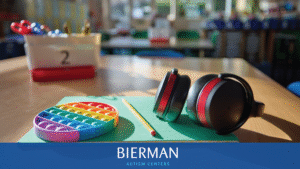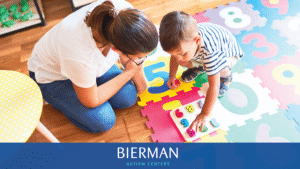Knowing what to expect when your child is playing can help you support your child as they learn to play differently and interact with siblings, friends, and peers. There are steps parents or guardians can take to help enhance your child’s play skills. It is also important to be aware of the different stages of play, it will help you understand what your child is comfortable with and how you can interact with them at their level. Playing is an important part of childhood and a place where many children learn skills they will use for the rest of their lives.
Why are play skills important?
● They increase healthy brain development
● They increase communication and language development
● They help develop and improve social skills, and physical, cognitive, and emotional strength
● They provide an alternative to rigid or repetitive behaviors
How do I know what to focus on as a parent/guardian?
There are five main steps that you can do to help enhance your child’s play interactions. These include observing, setting up the environment, pairing, teaching, and reinforcing desirable behaviors.
Let’s go into each of the areas:
Observe
The first step is to observe. This will help you identify and understand your child’s interests and how they play. What items do they gravitate toward? How do they like to play with those items? Do they want you to be involved with their play, or would they rather play alone? Is there any pattern in the way that your child engages with certain items, or does your child have any aversions in play, such as loud noises or different textures, or even another person interacting with their materials? Answering these questions will help you understand where to start when it comes to playing with your child.
Setup
The next thing you will want to focus on before your play starts is setting up the environment for success. This could be minimizing environmental distractions, such as decluttering the room or turning off electronics. It may also be important to go to an area where there aren’t other people around if your child seeks attention from many people or can get easily distracted. The setup process will look different depending on your child and depending on what skills you’re trying to teach. But if you’re aware of how your environment is affecting your child’s ability to learn that new skill, then you’ll be able to set your child up for success with learning something new.
Pairing
Paring with your child is the first step in the actual play interaction. This means that you will immerse yourself in your child’s play. Your goal here is to make the activity more fun for your child. When starting out, it’s important to follow your child’s lead, try to meet them where they are, and focus on making your play experience positive by easing into your play interaction.
The main idea with pairing is that you want to try to avoid placing any demands. At the same time, you’re focused on pairing so that you’re not accidentally making the activity harder or less enjoyable for your child. The objective is to enhance the activity and make it fun for your child. Just by being involved in it, your child will start paying attention to you more because you’re showing them new, fun ideas and things they can do that they enjoy.
Teach
Once you feel like you’ve paired yourself with the activity or item, it’s time to start teaching something new. First and foremost, you want to start small with your goals. You want to make sure your child’s play experience is positive. If they ever start showing signs of pulling back or not enjoying the activity, it’s time to scale back to pairing or focus more on that before pushing forward. For example, you can use prompts to help your child learn a new skill if you think the demands you’ve placed are too difficult for them. We recommend that you model the behavior that you want them to do yourself so that they have that model and can imitate it. You could also use a gesture to help guide them through an activity or provide verbal or physical prompts if they seem like they’re getting stuck.
Reinforce
The final step is to reinforce your child’s new play behaviors. You can give your child lots of positive feedback throughout the activity, such as saying, “Great job pushing the car down the ramp,” or “I love how you tried something new!” When you pair with your child, you may discover a fun, new way to play with the toy that your child really enjoyed. Continuing that activity could be the reinforcement because they’re really enjoying it.
Stages of Play
Next- let’s go into the different stages of play. Not all kids play the same way!
These are the different stages of play that your child might be engaging in. These stages of play will really help you to identify where your child is in their play and help you to figure out how you can become engaged in their play as well:
● Solitary Play: Playing solo without attending to others
● Onlooker Play: Still playing solo but watching others in their environment
● Parallel Play: Playing near others or with similar toys but not necessarily interacting together
● Associative Play: Sharing toys and communicating with others during play, but not necessarily working toward the same goal
● Cooperative Play: Playing with others while working toward a shared goal
Reminder
Your role in the play interactions with your child has a meaningful impact on your child’s ability to learn new ways to play. It may take more analysis on your part than you’re used to, but if you can remember these five steps: observe, set up the environment, pair, teach, and reinforce, then you’ll be able to make your interactions better and more meaningful for your child.
Note: This blog post is based on a Bierman Caregiver Webinar.


